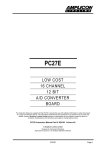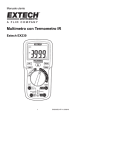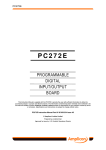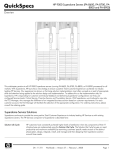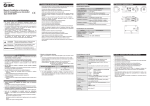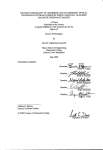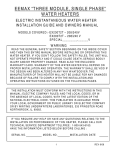Download EX230 - Amplicon
Transcript
EX213, 221, 230 & 233 EX213, 221, 230 & 233 TERMINATION AND DISTRIBUTION PANELS This Instruction Manual is supplied with the EX2xx series expansion panels to provide the user with sufficient information to utilise the purchased product in a proper and efficient manner. The information contained has been reviewed and is believed to be accurate and reliable, however Amplicon Liveline Limited accepts no responsibility for any problems caused by errors or omissions. Specifications and instructions are subject to change without notice. EX213, 221, 230, 233 Instruction Manual Part Nº 8596 6364 Issue C1 © Amplicon Liveline Limited Prepared by J. Hayward Approved for issue by A.S. Gorbold, Operations Director EX213, 221, 230 & 233 TERMINATION AND DISTRIBUTION PANEL TABLE OF CONTENTS 1. INTRODUCTION .........................................................................................................................4 1.1 1.2 1.2.1 1.2.2 1.3 1.4 1.4.1 1.4.2 1.5 1.6 1.6.1 1.6.2 2. The EX233 card What the EX233 Package Contains Quick Start Termination Setting up the EX233 Relay/Logic Output Configuration Source Driver/TTL Output Power Relays Connections 4. EX230 DIGITAL INPUT PANEL 4.1 4.2 4.3 4.4 4.5 Opto-isolation Volt free contact input Low/High Range Power Connections Description The Outputs Relay/Logic Output Configuration Source Driver/TTL Output Relays The Inputs Power Connections 13 13 13 13 14 15 15 15 15 15 16 17 17 MECHANICAL DETAILS...........................................................................................................19 6.1 6.2 7. 11 11 11 12 12 EX221 MIXED INPUT AND OUTPUT PANEL 5.1 5.2 5.3 5.4 5.5 5.6 5.7 5.8 6. 9 9 9 10 EX213 DIGITAL OUTPUT PANEL...............................................................................................11 3.1 3.2 3.3 3.4 3.5 5. 4 4 4 5 5 7 7 7 8 8 8 8 EX233 TERMINATION AND DISTRIBUTION PANEL..................................................................9 2.1 2.2 2.3 2.4 3. The Amplicon 200 Series The 200 Series Digital I/O Counter/Timer Family Typical Applications Product List Product Configuration Features Summary of the Expansion Panels Expansion Panels Common Features Expansion Panels Individual Features The Amplicon Warranty Covering the cards Contacting Amplicon Liveline Limited for Support or Service Technical Support Repairs Mounting the Panel on a DIN Carrier Rail Mounting the EX233 Board on a Flat Panel 19 19 MAKING THE CONNECTIONS .................................................................................................20 7.1 7.1.1 7.2 7.3 7.3.1 The input/output Connector Use of Shielded Cable Connections The Cage Clamp Terminals The Distribution Connectors PCI236 Compatibility 20 20 20 21 21 EX213, 221, 230 & 233 7.3.2 7.3.3 7.4 7.4.1 7.4.2 7.4.3 7.5 8. 8.1 8.2 8.3 8.4 Unused Input Termination Distribution Connection Map for the EX233 Powering the EX230 series Host Computer +5 Volt Supply Auxiliary +5 Volt Supply Auxiliary ±12 and -5 Volt Power Supply Chassis Ground Connection 22 23 24 24 24 24 25 LAYOUT DIAGRAMS ................................................................................................................26 EX213 LAYOUT DIAGRAM EX221 LAYOUT DIAGRAM EX230 LAYOUT DIAGRAM EX233 LAYOUT DIAGRAM 26 27 28 29 EX213, 221, 230 & 233 1. INTRODUCTION 1.1 The Amplicon 200 Series The Amplicon 200 Series of Personal Computer based data acquisition products provides very high performance, affordable hardware with comprehensive software support. The 200 Series is designed for users requiring fast or complex data input/output to the host PC and comprises a range of boards and software to handle most analogue and digital signal types. When a large scale system is required, multiple boards can be added from the 200 Series without conflict. The capacity of the PC mounted hardware can be extended by external expansion panels to provide a comprehensive system with low cost per channel and maintained high performance. 1.2 The 200 Series Digital I/O Counter/Timer Family The family of 200 Series digital input/output products may be configured in a variety of ways to provide flexible, expansible systems. Three digital input/output boards with timer/counter facilities are offered. These three boards are complemented by four external panels for signal conditioning and user connection through individual terminals. Support and demonstration software for all variants is offered. A full, itemised list of hardware products is shown in 1.2.2, and a configuration diagram showing how these products interact is also given. To complete the family, a common software package AMPDIO supports all digital I/O boards and the expansion panels. 1.2.1 Typical Applications • TTL compatible digital input/output • Relay output with isolated contacts, high level ground referenced source drivers (any combination) • Isolated high or low level digital input, ground referenced high or low level digital input (any combination) • Elapsed time, period, frequency measurement • Differential, ratiometric count • Monostable and astable generation • Frequency division, frequency multiplication, digitally controlled oscillator Page 4 EX213, 221, 230 & 233 1.2.2 Product List Product Number Product Type Brief Description PCI215 PCI272 Counter/timer, Digital I/O board Digital I/O board 6 counters, clock/gate source, 48 line digital I/O 72 line digital I/O EX233 EX213 EX230 EX221 Termination/distribution panel Output panel Input panel Input/output panel 78 Terminals, 3 x 37 way distribution connectors 24 relay or high level logic source drivers 24 isolated or non-isolated, high or low level inputs 16 inputs, 8 outputs 9096 6349 9101 4890 78 way Screened Cable 1m 37 way Screened Cable 1m I/O board to EX233 Termination/distribution panel PCI236 or EX233 to I/O panel PCI236 9089 1950 9194 5953 Digital I/O Board 37 way screw terminal assy 78 way Screened Connector Kit 24 Line Digital I/O Board 1.3 Product Configuration Figure 1 - Product Configuration Block Diagram - shows how the digital I/O boards may be connected to form a variety of systems, by using the supplied cables. The simplest system configuration comprises one board (either PCI215 or PCI272), a 78 way cable and an EX233. This system provides user terminals to all I/O functions of the board. More complex, configurable systems include isolated or common ground input and output at low or high level. These boards employ the concept of I/O Groups, where a group can be six 16 bit counter timers with interconnects, or 24 lines of digital input/output. These groups are integrated as necessary to provide the specified functionality. A clock source group provides five precise frequencies for counter/timer input. The PCI215 has software configurable clock and gate source groups. The user I/O connector map recognises this grouping and allows any combination of expansion panels to be directly added to any of the boards, with each panel mapped onto a counter/timer group or digital I/O group. Page 5 EX213, 221, 230 & 233 EX 213 24 O/P PCI272 EX233 78 way termination and 3x37 way distribution 72 Lines Digital I/O OR PCI215 OR EX 230 78 way cable 6 Counters 48 Lines Digital I/O 24 I/P AND /OR 37 way cable EX 221 OR 37 way Cable OR 8 O/P PCI236 24 Lines Digital I/O 37 way termination assy Figure 1 - Product Configuration Block Diagram Page 6 16 I/P EX213, 221, 230 & 233 1.4 Features Summary of the Expansion Panels As with the digital I/O boards, the expansion panels are of modular design employing common circuit groups and constructional techniques. 1.4.1 Expansion Panels Common Features • • • • • • • • • 1.4.2 200 Series compatible DIN rail mounting Cage clamp terminals Common circuit groups 78-way shielded connector for user I/O 37-way shielded interconnect cables Connection groups compatible with I/O boards Multiple ground I/O connections User manual Expansion Panels Individual Features Number EX233 EX213 EX230 Termination and 24 Line Digital 24 Line Digital Function Distribution Output Panel Input Panel Panel TTL level 24 isolated relay 24 isolated or Operations termination and/or outputs non-isolated high distribution 24 high level or low level inputs source drivers Input Connector User Terminals Power Required Set-up 78 way 78 TTL level I/O terminals 3x37 way distribution connectors None required None 37 way 37 way 24 relay O/P 24 input pairs (48) 16 input pairs (32) groups of 3 (72) Gnd / Power (2) 8 relay O/P (24) 24 high level 8 high O/P (8) O/Ps (24) Gnd / Power (6) Gnd / Power (4) 24 VDC +5 V from PC 24 VDC +5 V from PC Individual bit by Individual bit by Individual bit by jumpers jumpers jumpers Figure 1.1- Expansion Panel individual features. Page 7 EX221 16 Line Input, 8 Line Output Panel 16 isolated or non-isolated high or low level inputs 8 relay and driver outputs 37 way EX213, 221, 230 & 233 1.5 The Amplicon Warranty covering the cards This product is covered by the warranty as detailed in the Terms and Conditions stated in the current domestic or international Amplicon Liveline catalogue. 1.6 Contacting Amplicon Liveline Limited for Support or Service These boards are produced by Amplicon Liveline Limited and maintenance is available throughout the supported life of the product. 1.6.1 Technical Support Should this product appear defective, please check the information in this manual and any 'Help' or 'README' files appropriate to the program in use to ensure that the product is being correctly applied. If a problem persists, please request Technical Support on one of the following numbers: Telephone: UK 0844 324 0617 Calls cost 5p per min from a BT landline. Calls from other services may vary Fax: UK E-mail Web 1.6.2 01273 570 215 [email protected] www.amplicon.com Repairs If the product requires repair then please return the goods enclosing a repair order detailing the nature of the fault. If the product is still under warranty, there will be no repair charge unless any damage as a consequence of improper use. For traceability when processing returned goods, a Returned Materials Authorisation (RMA) procedure is in operation. Before returning the goods, please request an individual RMA number by contacting Amplicon Customer Services by telephone or fax on the above numbers. Give the reason for the return and, if the goods are still under warranty, the original invoice number and date. Repair turnaround time is normally five working days but the Service Engineers will always try to co-operate if there is a particular problem of time pressure. Please mark the RMA number on the outside of the packaging to ensure that the package is accepted by the Goods Inwards Department. Address repairs to: Page 8 Customer Services Department AMPLICON LIVELINE LIMITED Centenary Industrial Estate Hollingdean Road BRIGHTON UK BN2 4AW EX213, 221, 230 & 233 2. EX233 TERMINATION AND DISTRIBUTION PANEL 2.1 The EX233 card • The EX233 accepts a 78-way cable from any of the 200 Series Digital I/O - Counter Timer boards (namely PCI215 and PCI272). • The EX233 distributes these 78 lines on three rows of 26 cage-clamp terminals, each row being a 24 line PPI or six counter/timer group. Signals on these terminals are TTL compatible, referred to the PC ground. • The EX233 also distributes these 78 lines to three 37-way D connectors compatible with the pin-outs of the Amplicon PCI236 Digital Input/Output board. Connection can then be made to the EX213, EX230, and EX221 I/O panels via 37-way cables. Any one of these three panels can also be directly connected to a PCI236. The EX233 termination and distribution panel connects to the 78 way connector on the PCI215 or PCI272. Install the board inside the host computer (PC), referring to section 2 'Getting Started' of the Digital I/O board's manual, and the PC's technical manual for instructions. Ensure the board's front panel is securely fastened to the PC chassis. The 78-way connector will protrude through the chosen I/O slot of the PC. 2.2 What the EX233 Package Contains The package as delivered from Amplicon Liveline Ltd. contains:Item 1 EX233 supplied in an antistatic packaging. Item 2 Softman CD, for manual and software 2.3 Quick Start Termination 1. Connection to the EX233 should be made by means of a 78-way screened cable. This is a standard cable available from Amplicon, and has been designed to meet EMC requirements. See Section 3.1.1 for more details. 2. Mount the EX233 in a suitable position for the cable to reach, and, ensuring that the PC is turned OFF, connect the EX233 to the Digital I/O board. Ensure that the connectors are pressed firmly home and the jack-screws are firmly tightened. Handle the cable assemblies by the connector bodies when inserting or extracting the connectors. 3. The 'quick start' termination system is now ready to use, and all of the I/O signals on the Digital I/O board's 78-way connector are now available at the cage-clamp terminals X, Y and Z on the EX233 panel. See Section 3 for instructions on using the 37-way distribution connectors and auxiliary +5 Volt power connector. Page 9 EX213, 221, 230 & 233 2.4 Setting up the EX233 Jumper J1 selects the source of the EX233's +5 Volt power as follows: J1 VCC +5V EX233 +5 Volt Power from host PC (via 78 way connector) from PL5 auxiliary power connector. Figure 2 - Jumper Selection for +5V Power See Section 7.4.2 for a discussion on providing auxiliary power to the EX233. Page 10 EX213, 221, 230 & 233 3. EX213 DIGITAL OUTPUT PANEL Description The EX213 is a 24 line digital output card with 24 Change Over contact relays, 24 Hi Current sourcing open emitter outputs, or 8 TTL outputs, selected by the position of jumpers. 3.1 Relay/Logic Output Configuration Relay or logic outputs can be selected by the position of jumpers J12 to J35. Logic outputs are given on SK2, while relay outputs use SK7 and SK8. Details of the individual per bit Normally Open (N/O), Normally Closed (N/C) and Common (COM) output configuration is labelled on the panel. To select Logic output, ensure that J12 to J35 are configured as LOGIC as per the RELAY/LOGIC OUTPUT CONFIGURATION diagram on the EX213. To set the entire board to relay output, set the Jumpers across the pins next to the relays. For a logic output simply place the jumpers in the opposite position. Any combination of logic and relay outputs is allowed. 3.2 Source Driver/TTL Output Only selectable on Port or Block A of the card. To select TTL output on block A of the EX213s outputs, set J4 to J11 to TTL OUTPUT as displayed on the panel. Alternatively, Block A can be set to output at the same level as the source driver by setting J4 to J11 to SOURCE DRIVER OUTPUT, for this mode set the Jumpers across the pins next to the relays. Any combination of output types is allowed. Relay operation will only work in source driver mode. Low/High Range The EX213 outputs : Isolated relay contact output mode PPI Output = ‘0’ PPI Output = ‘1’ N/O contact open N/O contact closed High level logic output mode : Output voltage low (PPI output = ‘0’) Output voltage high (PPI output = ‘1’) +0.7V +23V 3.3 Power The EX213 must be powered by an external 24V power supply, such as DR-4524 (Order Code 9604 8563). External power should be connected per channel to the EX213 via SK6, which is clearly labelled as to the GND and VCC connections. It should be noted that the source driver chip could source up to 100mA for 90% duty cycles on all 24 lines. Jumpers J1 to J3 connect the logic ground of the computer to the grounds of the relay drivers. A ground connection should be made for correct operation of the board, however J1-3 may be removed if this creates a ground loop. Page 11 EX213, 221, 230 & 233 3.4 Relays The relays used on the EX213 card are of the RY2 8 Amp low profile range. These have a silver/cadmium oxide contact and are rated at 8 Amps @250 Vac or 30 Vdc The coil on each relay is a nominal 2350 Ohms. Normal operating temperature: –20 to 60 deg C. The relays are sealed to IP67 rating. 3.5 Connections Connections from the PC to the EX213 come via your chosen Digital I/O Counter Timer board, via a 78 way cable to the EX233 Distribution Panel. The EX233 splits the 72 lines of Digital I/O Counter Timer signals into three groups, Groups X, Y and Z. Each group contains either three 8-bit digital IO ports or six CLK/GATE counter timer inputs and outputs. Each group has its own 37-way D connector (male) and a row of 26 WAGO connectors, each for an individual line. Connection to the EX213 should be made using a 37-way cable (Order code 9101 4890) from the EX233 to SK4 on the EX213. Each output has either a direct ‘logic’ connection (SK2), or a two row block of WAGO connectors (SK7 and SK8) if the board is configured for relay output. There is also a ‘shared bus’ feature, which allows the user to make either a signal or a power connection to SK3 on the EX233 and it will be brought out on SK5 of the EX213. Both of the EX213s sister boards the EX221 and EX230 also have this feature, see Section 7.3.2 for further details. Page 12 EX213, 221, 230 & 233 4. EX230 DIGITAL INPUT PANEL The EX230 is a 24 line digital input card with jumper selectable options for nominal 5 or 24 volt input operation with or without opto-isolation on the inputs. It is part of the Amplicon 200 Series, and is designed for use in conjunction with the EX233 and our 200 Series range of Digital I/O and Counter Timer products. 4.1 Opto-isolation To select opto-isolation on the EX230s inputs set J31 to J54 to OPTO-ISOLATED INPUT MODE as displayed on the panel. Opto-isolation is selected per bit, any combination of isolated and nonisolated inputs are allowed. 4.2 Volt free contact input To select a Volt free contact input, set J31 to J54 to LOGIC LEVEL INPUT this allows the input to float up to +5 Volts supplied from VCC. This input can then be pulled to ground by an external contact closure. This mode can also be used as a buffered TTL level logic input to the 200 Series cards. 4.3 Low/High Range The EX230 can operate within the following voltage ranges:Opto-isolated input mode : Input Signal low (‘0’ at PPI input) Input Signal high (‘1’ at PPI input) Low Range J7- J30 Inserted High Range J7- J30 Removed -5V to +1.5V +4.0V to +20V -15V to +2.0V +10V to +50V Volt free contact input mode : Input Signal low (‘0’ at PPI input) Input Signal high (‘1’ at PPI input) -1V to +1.5V +2.0V to +5.0V Low range is selected when jumpers J7 to J30 are fitted, high range is selected when J7 to J30 have been removed. Low/High range can be individually selected for each bit, and any combination of the two ranges is allowed. Light Emitting Diodes D1 – D24 indicate status of the input. Please note that negative logic applies to the volt free contact settings. 4.4 Power The EX230 can be powered in two different ways. It can either be powered from the PC via the Digital I/O Counter Timer board and the EX233 distribution panel, or it can be powered from an external power supply, such as a DR-4524 (Order Code 9604 8563). If J1 to J6 are fitted, power is provided from the PC. However, if jumpers J1 to J6 are removed, power must be provided from an external power supply. External power must be connected per channel to the EX230 via SK5, which is clearly labelled as to the GND and VCC connections. It should be noted that a ground return path must be completed for the card to function correctly, and recommend that the unit is powered from the computer supply. Page 13 EX213, 221, 230 & 233 4.5 Connections Connections from the PC to the EX230 come via your chosen Digital IO/Counter Timer board, out via a 78 way cable (Order Code 9096 6349) to the EX233 Distribution Panel (Order Code 9096 6333). The EX233 splits the 72 lines of Digital IO/Counter Timer signals into 3 groups, Groups X, Y and Z. Each group contains either three 8-bit digital IO ports or six CLK/GATE counter timer inputs and outputs. Each group has its own 37-way D connector (male) and a row of 26 WAGO connectors, each for an individual line. Connection to the EX230 should be made using a 37 way cable (Order Code 9101 4890) from the EX233 to SK3 on the EX230. We recommend that opto-isolated inputs are used for all inputs to the computer. This provides a greater tolerance to noise Each input has its own I/P and 0V connection, The I/P (SK7) is connected to the positive side of the opto isolator with 0V (SK8) connected to the negative. Both of these inputs are clearly marked on the silk-screen. For convenience, Jumpers J55- J75 connect the 0V inputs together in each group, so A0 0V is connected to A1 0V using J55. +5V HI/LOW 470R J31 Volt Free I/P # 10K 470R To EX233 and Amplicon dio card Opto isolated 0v 1K5 J55 AGND To 0v on next channel Figure 4 Channel A0 - input to the card There is also a ‘shared bus’ feature, which allows the user to make either a signal or a power connection to SK3 on the EX233 and it will be brought out on SK4 of the EX230. Both of the EX230s sister boards the EX213 and EX221 also have this feature, see Section 7.32 for further details. Page 14 EX213, 221, 230 & 233 5. EX221 MIXED INPUT AND OUTPUT PANEL 5.1 Description The EX221 card has eight digital output channels and 16 line digital inputs. The outputs can be configured by jumpers to provide Change Over contact relays, high current sourcing open emitter outputs, or TTL outputs. The inputs can be configured for a nominal 5 or 24 volt input operation with or without opto-isolation on the inputs, or a volt free contact input. It is part of the Amplicon 200 Series, and is designed for use in conjunction with the EX233 and our 200 Series range of Digital I/O and Counter Timer products. 5.2 The Outputs 5.3 Relay/Logic Output Configuration Relay or logic outputs can be selected by the position of jumpers J30 to J37. Logic outputs are given on SK2, while relay outputs use SK8 and SK10. Details of the individual per bit Normally Open (N/O), Normally Closed (N/C) and Common (COM) output configuration are given on the silkscreen. To select Logic output, ensure that J30 to J37 are configured as LOGIC as per the RELAY/LOGIC OUTPUT CONFIGURATION diagram on the silkscreen of the EX221. To set the entire board to relay output, set the jumpers across the pins nearest to the relays. For a logic output simply place the jumpers in the opposite position. Any combination of logic and relay outputs is allowed. 5.4 Source Driver/TTL Output To select TTL output on Block A of the EX221s outputs set J6 to J13 to TTL OUTPUT as displayed on the silkscreen. Alternatively, the outputs can be set to output at the same level as the source driver by setting J6 to J13 to SOURCE DRIVER OUTPUT. For this mode set the Jumpers across the pins furthest from the relays. Any combination of output types is allowed. Relay operation will only work in source driver mode. Low/High Range The EX221 outputs : Isolated relay contact output mode PPI Output = ‘0’ PPI Output = ‘1’ N/O contact open N/O contact closed High level logic output mode : Output voltage low (PPI output = ‘0’) Output voltage high (PPI output = ‘1’) +0.7V +23V 5.5 Relays The relays used on the EX221 card are of the RY2 8 Amp low profile range. These have a silver/cadmium oxide contact and are rated at 8 Amps @250 Vac or 30 Vdc The coil on each relay is a nominal 2350 Ohms. Normal operating temperature: –20 to 60 deg C. The relays are sealed to IP67 rating. Page 15 EX213, 221, 230 & 233 5.6 The Inputs The EX221 has 16 lines digital input card with jumper selectable options for nominal 5 or 24 volt input operation with or without opto-isolation on the inputs. Opto-isolation To select opto-isolation on the EX221s inputs set J43 to J58 to OPTO-ISOLATED INPUT MODE as displayed on the silk-screen. Opto-isolation is selected per bit, any combination of isolated and nonisolated inputs are allowed. Volt free contact input To select a Volt free contact input set J43 to J58 to LOGIC LEVEL INPUT this allows the input to float up to +5 Volts supplied from VCC. This input can then be pulled to ground by an external contact closure. This mode can also be used as a buffered TTL level logic input to the 200 series cards. Low/High Range The EX221 can operate within the following voltage ranges: Opto-isolated input mode : Input Signal low (‘0’ at PPI input) Input Signal high (‘1’ at PPI input) Low Range J14- J29 Inserted High Range J14 – J29 Removed -5V to +1.5V +4.0V to +20V -15V to +2.0V +10V to +50V Volt free contact input mode : Input Signal low (‘0’ at PPI input) Input Signal high (‘1’ at PPI input) -1V to +1.5V +2.0V to +5.0V Low range is selected when jumpers J14 to J29 are fitted, high range is selected when J14 to J29 have been removed. Low/High range can be individually selected for each bit, and any combination of the two ranges is allowed. Light Emitting Diodes D1 – D16 indicate status of the input. Please note that negative logic applies to the volt free contact inputs. Jumpers J59- J72 These jumpers connect the 0V inputs together in each group so B0 0V is connected to B1 0V, by using J66 for ease of wiring. Page 16 EX213, 221, 230 & 233 5.7 Power The EX221 must be powered by an external 24V power supply, such as a DR-4524 (Order Code 9604 8563). External power should be connected per channel to the EX221 via SK6, which is clearly labelled as to the GND and VCC connections. Care should be taken to only apply 24 Volt power to A VCC and A GND to avoid damage to other circuits. It should be noted that the source driver chip could source up to 100mA for 90 % duty cycles on all lines. A Jumper J1, connects logic ground of the computer to the grounds of the relay drivers. A ground connection should be made for correct operation of the board, however J1 may be removed if this creates a ground loop. The EX221 can be powered in two different ways. It can either be powered from the PC via the Digital IO/Counter Timer board and the EX233 distribution panel, or it can be powered from an external power supply, such as a DR-4524 (Order Code 9604 8563). If J2 to J5 are fitted, power is provided from the PC. However, if jumpers J2 to J5 are removed, power must be provided from an external power supply. External power must be connected per channel to the EX221 via SK6, which is clearly labelled as to the GND and VCC connections. It should be noted that a ground return path must be completed for the card to function correctly, and recommend that the unit be powered from the computer supply with J 1 to 5 fitted. 5.8 Connections Connections from the PC to the EX221 come via your chosen Digital IO/Counter Timer board, out via a 78 way cable to the EX233 Distribution Panel. The EX233 splits the 72 lines of Digital IO/Counter Timer signals into 3 groups, Groups X, Y and Z. Each group contains either three 8-bit digital IO ports or six CLK/GATE counter timer inputs and outputs. Each group has its own 37 way D connector (male) and a row of 26 WAGO connectors, each for an individual line. Connection to the EX221 should be made using a 37 way cable (Order Code 9101 4890) from the EX233 to SK4 on the EX221. Each output has either a direct ‘logic’ connection (SK2) or a two-row block of WAGO connectors (SK8 and SK10) if the board is configured for relay output. Each input has its own I/P and 0V connection, The I/P SK7 is connected to the anode + side of the opto isolator with SK9 connected to the 0V - cathode. Both of these inputs are clearly marked on the silk-screen. We recommend that opto-isolated inputs be used for all inputs to the computer. This provides a greater tolerance to noise For convenience Jumpers J59 - J72 connect the 0V inputs together in each group so B0 0V is connected to B1 0V by using J66. Page 17 EX213, 221, 230 & 233 +5V J14 HI/LOW 470R J43 I/P 10K Volt Free # Opto isolated 2K2 To EX233 and Amplicon DIO Card Input B0 0v 1K5 BGND J66 To 0v on next channel Figure 5.0 Input B0 of EX221 card There is also a ‘shared bus’ feature, which allows the user to make either a signal or a power connection to SK3 on the EX233 and it will be brought out on SK5 of the EX221., see Section 7.3.2 for further details. Page 18 EX213, 221, 230 & 233 6. MECHANICAL DETAILS 6.1 Mounting the Panel on a DIN Carrier Rail The EX2xx series can be clipped onto a standard DIN/ES carrier rail. Suitable rails are the TS32 'G' section rail or TS35 'top hat' section rail. Figure illustrates the method of mounting to the two types of rail. ‘G’ Section TS 32 Rail ‘Top Hat’ Section TS 35 Rail Figure 6.0 - Mounting an EX2xx series card on a DIN Rail The frame includes three plastic carrier feet, which are all assembled in the same direction. Locate the fixed slot of each foot over the appropriate rail edge and carefully press the whole assembly down onto the rail until all four feet click into position. To dismount the EX2xx series card in its frame, lift all three 'handles' to release from one rail edge and unhook from the other edge. 6.2 Mounting the EX233 Board on a Flat Panel If the EX233 card is to be mounted on a flat panel, four insulated spacers are required. The dimensions of the mounting hole centers are given in Figure 6.1. Fixing screws are 3mm Ø. This mounting pillar (metal) may be used for connection to chassis ground 264.0 mm (10.13”) 254.0 mm (10.0”) 121.9 mm (4.8”) 88.9 mm (3.5”) 5.0 mm (0.07”) 16.5 mm (0.65”) Figure 6.1 - EX233 Board Mounting Dimensions This mounting pillar (metal) may be used for connection to chassis ground The EX213, EX221 and EX230 dimensions are 316.5 mm by 121.9 mm and do not have holes for panel mounting. Page 19 EX213, 221, 230 & 233 7. MAKING THE CONNECTIONS 7.1 The Input/Output Connector The input/output connections from the Digital I/O board host are made through the 78 way connector, PL1. The pin designations for this connector will vary according to the Digital I/O board that is connected to the EX233. Please refer to Section 3.1 of the Digital I/O board's manual for the pin designations of the 78 way connector. 7.1.1 Use of Shielded Cable Connections A 78 way cable is required to provide connection from the host Digital I/O board to the EX233. In order to maintain compliance with the EMC directive, 89/336/EMC, it is mandatory that the final system integrator uses good quality screened cables and metal hoods for external connections. It is up to the final system integrator to ensure that compliance with the directive is maintained. Amplicon Liveline offers a screened 78-way cable with metal shielded 'D' connectors (Part Nº 9096 6349) in its series of good quality screened cables for this purpose. Please contact our sales staff. 7.2 The Cage Clamp Terminals The EX233 terminates the 78 signals from the input/output connector onto three groups of 26 cage clamps: Group X, Group Y and Group Z. These three groups correspond to the three I/O groups X, Y and Z on the host digital I/O board, whereby each group is populated by either 24 digital I/O lines, or six 16-bit timer/counters according to the board being used. Each cage clamp has two signal names next to it on the printed circuit board: one describing the corresponding digital I/O signal, and one describing the corresponding timer/counter signal. Only one of these names will apply to the cage-clamp signal, according to the Digital I/O board being used. Figure 7.0 below gives the group X, Y and Z designations for each of the boards in the 200 Series Digital I/O family. Board PCI215 PCI272 X DIO DIO Y DIO DIO Z T/C DIO Figure 7.0 - Group X, Y and Z Designation It is recommended that the silk-screen names that do not apply to the board being used are 'blacked-out', using masking tape for example, to avoid confusion of the signal names. All input/output terminals to the EX233 are of the lever operated, cage-clamp type, allowing quick, easy and reliable connection of any compatible wire size. If more than one wire is to be held in a single terminal, prepare these wires by stripping and twisting together before clamping. Each terminal on the EX233 is provided with a built-in push lever to operate the cage-clamp. The lever may be depressed using a small screwdriver or other convenient tool, and when the clamp is opened, the wire to be connected is pushed home in the slot and the operating lever released. Page 20 EX213, 221, 230 & 233 Small Screwdriver Prepared Signal Wire Figure 7.1 - Operating the Cage Clamp Terminal 7.3 The Distribution Connectors The three 37 way D connectors PL2, PL3 and PL4 provide individual distribution of the Group X, Group Y and Group Z signals respectively. This feature is primarily geared towards use with the digital I/O group(s) of the board being used in order to connect the signals to one or more of the additional expansion panels in the 200 Series Digital I/O family. The EX213, EX230 and EX221 expansion panels add relay or high level logic output drivers and isolated or high level inputs for any Digital I/O group of any board in the 200 Series Digital I/O family. See section 1.4 for a more detailed description of these expansion panels. 7.3.1 PC236 compatibility The pin designations of the three 37-way distribution connectors, when used with Digital I/O group PPIX, PPIY or PPIZ, are given in Figure 7.2 below. These pin designations are compatible with the Amplicon PCI236 Digital I/O board, which provides 24 lines of digital I/O (i.e. equivalent to one 200 Series Digital I/O group PPIX, PPIY or PPIZ). This makes it possible for the PCI236 board to take advantage of the features of the EX213, EX230 or EX221 input/output panels by connecting directly to the panels via a 37-way cable. The ±12 and -5 Volt power supplies on the 37-way distribution connectors are not provided by the host 200 Series Digital I/O board, unlike the PCI236 - only the +5 Volt supply is provided. These additional power signals must be provided externally via the auxiliary power connector, PL5. See section 7.4.3 for details. Page 21 EX213, 221, 230 & 233 19 Port B7 37 GND 18 Port B6 36 SK3-8 17 Port B5 35 SK3-7 16 Port B4 34 SK3-6 15 Port B3 33 -12 V 14 Port B2 32 SK3-5 13 Port B1 31 SK3-4 12 Port B0 30 -5 V 11 Port A7 29 SK3-3 10 Port A6 28 SK3-2 9 Port A5 27 Port C7 8 Port A4 26 Port C6 7 Port A3 25 Port C5 6 Port A2 24 Port C4 5 Port A1 23 Port C0 4 Port A0 22 Port C1 3 SK3-1 21 Port C2 2 +5 V 20 1 Port C3 +12 V Figure 7.2- Digital I/O Distribution 37 way Connector Pin Designation As inputs of the EX233 and outputs of the EX213, EX221 and EX230 7.3.2 Unused Input Termination The 37 way distribution connectors PL2, PL3 and PL4 include eight unused pins (3, 28, 29, 31, 32, 34, 35 and 36). These pins are also unused (not connected) on the PCI236 board. Each of these unused pins is available on a separate cage-clamp terminal of socket SK3 of the EX233, and joined to the corresponding unused pins of the other distribution connectors as follows. PL2, PL3 and PL4 pin number 3 28 29 31 32 34 35 36 SK3 terminal number 1 2 3 4 5 6 7 8 Figure 7.3 - Unused Distribution Connector Pins This allows for up to eight additional external signals to be distributed from the EX233 on all three 37-way connectors. Page 22 EX213, 221, 230 & 233 7.3.3 Distribution Connection Map for the EX233 A table showing how the 78 way connections are mapped onto the EX233 terminals and distributed to the three 37 way D connectors is shown below. 78 way 1 2 3 4 5 6 7 8 9 10 11 12 13 14 15 16 17 18 19 20 21 22 23 24 25 26 27 28 29 30 31 32 33 34 35 36 37 38 39 40 41 42 43 44 45 46 47 48 49 50 51 52 53 54 55 56 57 58 59 60 61 62 63 64 65 66 67 Page 23 37 way Group X 2 8 4 24 22 17 13 10 6 26 20 19 15 11 7 27 37 23 16 12 9 5 25 21 18 14 - 37 way Group Y 2 10 6 26 20 19 15 8 4 24 22 17 13 9 5 25 21 18 14 11 7 37 way Group Z 2 8 4 24 22 17 13 10 6 26 20 19 15 11 7 27 37 23 16 12 - Terminal Row X 26 4 8 12 16 20 24 2 6 10 14 18 22 1 5 9 13 17 21 25 3 7 11 15 19 23 - Terminal Row Y 26 2 6 10 14 18 22 4 8 12 16 20 24 3 7 11 15 19 23 1 5 Terminal Row Z 26 4 8 12 16 20 24 2 6 10 14 18 22 1 5 9 13 17 21 25 - PPI Function +5 VDC O/P X Port A4 X Port A0 X Port C4 X Port C1 X Port B5 X Port B1 Y Port A6 Y Port A2 Y Port C6 Y Port C3 Y Port B7 Y Port B3 GND Z Port A4 Z Port A0 Z Port C4 Z Port C1 Z Port B5 Z Port B1 X Port A6 X Port A2 X Port C6 X Port C3 X Port B7 X Port B3 GND Y Port A4 Y Port A0 Y Port C4 Y Port C1 Y Port B5 Y Port B1 Z Port A6 Z Port A2 Z Port C6 Z Port C3 Z Port B7 Z Port B3 X Port A7 X Port A3 X Port C7 GND X Port C0 X Port B4 X Port B0 Y Port A5 Y Port A1 Y Port C5 Y Port C2 Y Port B6 Y Port B2 Z Port A7 Z Port A3 Z Port C7 GND Z Port C0 Z Port B4 Z Port B0 X Port A5 X Port A1 X Port C5 X Port C2 X Port B6 X Port B2 Y Port A7 Y Port A3 Counter Function +5 VDC O/P X1 OUT0 O/P X1 GAT1 I/P X1 OUT2 O/P X2 GAT0 O/P X2 GAT1 I/P X2 OUT2 O/P Y1 CLK0 I/O GND Y1 CLK2 I/O Ext Clock I/P Y2 Y2 /OUT0 O/P Y2 CLK2 I/O GND Z1 OUT0 O/P Z1 GAT1 I/P Z1 OUT2 O/P Z2 GAT0 I/P Z2 GAT1 I/P Z2 OUT2 O/P X1 CLK0 I/O GND X1 CLK2 I/O Ext Clock I/P X2 X2 /OUT0 O/P X2 CLK2 I/O GND Y1 OUT0 O/P Y1 GAT1 I/P Y1 OUT2 O/P Y2 GAT0 O/P Y2 GAT1 I/P Y2 OUT2 O/P Z1 CLK0 I/O GND Z1 CLK2 I/O Ext Clock I/P Z2 Z2 /OUT0 O/P Z2 CLK2 I/O Ext Clock I/P X1 X1 /OUT0 O/P X1 OUT1 O/P GND X2 OUT0 O/P X2 OUT1 O/P GND Y1 GAT0 I/P Y1 CLK1 I/O Y1 GAT2 I/P Y2 CLK0 I/O Y2 CLK1 I/O Y2 GAT2 I/P Ext Clock I/P Z1 Z1 /OUT0 O/P Z1 OUT1 O/P GND Z2 OUT0 O/P Z2 OUT1 O/P GND X1 GAT0 I/P X1 CLK1 I/O X1 GAT2 I/P X2 CLK0 I/O X2 CLK1 I/O X2 GAT2 I/P Ext Clock I/P Y1 Y1 /OUT0 O/P EX213, 221, 230 & 233 68 69 70 71 72 73 74 75 76 77 78 Shield Shield 27 37 23 16 12 Shield 9 5 25 21 18 14 Shield Earth Tag 9 13 17 21 25 Earth Tag - 3 7 11 15 19 23 Y Port C7 GND Y Port C0 Y Port B4 Y Port B0 Z Port A5 Z Port A1 Z Port C5 Z Port C2 Z Port B6 Z Port B2 Y1 OUT1 O/P GND Y2 OUT0 O/P Y2 OUT1 O/P GND Z1 GAT0 I/P Z1 CLK1 I/O Z1 GAT2 I/P Z2 CLK0 I/O Z2 CLK1 I/O Z2 GAT2 I/P Figure 7.4 - EX233 Distribution Connection Map 7.4 Powering the EX230 series 7.4.1 Host Computer +5 Volt Supply The EX233 is supplied with jumper J1 configured for operation from the computer's +5 V supply rail. This +5V supply comes into the EX233 from the 78-way connector via a 1.0 Amp fuse, and is available on each of the X, Y and Z group terminals and also on the three 37 way distribution connectors. The fuse, F1 is provided on all the cards to protect the host computer's power supply. If more than 1.0 Amp of current is drawn from the +5V terminals and/or 37 way distribution connectors on the cards and jumper J1 is set to position VCC, the fuse will blow, causing the connection to the host computer's +5V power rail to become open circuit. The fuse is fitted into a two pin socket and can easily be replaced. The part fitted by Amplicon is a WICKMAN Fast Blow 19370K1A fuse. Please disconnect the EX233 from the host computer before replacing the fuse, by removing the 78 way cable. 7.4.2 Auxiliary +5 Volt Supply Powering the EX233 from an auxiliary +5V supply will require the repositioning of jumper J1 in position '+5V’. Connect +5 V from an external power source to pin 4, and 0V to pin 5 of the Auxiliary Power Connector PL5. 7.4.3 Auxiliary ±12 and -5 Volt Power Supply In order to maintain compatibility with the PCI236 Digital I/O board's 37 way connector pin-out, and to provide these power supplies to the three distribution connectors, ±12 and -5 Volt power must be provided from an external power source via the Auxiliary Power Connector PL5. 1 2 3 4 5 +12 V Aux. Power I/P – 12 V Aux. Power I/P - 5 V Aux. Power I/P +5 V Aux. Power I/P GND (Power Ground) Figure 7.5 - Auxiliary Power Connector PL5, EX233 Page 24 EX213, 221, 230 & 233 7.5 Chassis Ground Connection Two cage-clamp terminals are provided on the series for connection to the chassis ground, SK1 and SK2. These terminals are connected on the board to the 78 way and 37 way connector metalwork for good earth bonding to the cable shields, and also to one of the mounting feet holes, for good earth bonding to the flat panel housing, if applicable - see Section 6.2 for details. Page 25 EX213, 221, 230 & 233 8. LAYOUT DIAGRAMS 8.1 EX213 LAYOUT DIAGRAM Page 26 EX213, 221, 230 & 233 8.2 EX221 LAYOUT DIAGRAM Page 27 EX213, 221, 230 & 233 8.3 EX230 LAYOUT DIAGRAM Page 28 EX213, 221, 230 & 233 8.4 EX233 LAYOUT DIAGRAM Page 29






























